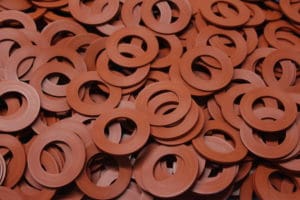A Guide to Die-cut Gaskets
What is a gasket?
A gasket is a piece of material that can be pressed between the faces or flanges of a joint to provide a seal.
Gaskets allow for any tolerance to be taken up between the two faces, and also mask any surface irregularities, so that under compression the gasket forms a seal.
They can be oil or water seals, operating at low or high temperatures or pressures. We will have a material to suit all types of situation.
Uses include
- anti-vibration
- supporting mounts
- noise reduction
- sealing
 What materials can be used to make Die-cut Gaskets?
What materials can be used to make Die-cut Gaskets?
Gaskets can be made of paper, rubber, felt, cork or any other material that can be pressed between the faces or flanges of a joint to provide a seal.
Tooling associated with this type of product is low-cost, as a tool is comprised of a wooden block with protruding blades to form the design or shape of the part. The largest proportion of cost is material usage, so gasket tool design is critical.
Common Materials Guide
Commercial Quality Rubber
Commercial quality rubber is an entry-level material with a broad range of uses. It is mainly used in gaskets for anti-vibration solutions.
It is not, however, a suitable material when creating seals and should not be used in products that may be subject to high pressures, heat or chemicals such as acid.
Typical uses include rubber feet for domestic appliances like televisions, where it acts as a noise reducer and protects against wear and friction.
EPDM Foam
If you are looking for a gasket that is water-resistant; can handle extreme temperatures (both hot and cold); is resistant to ozone and incredibly long-lasting, then EPDM is the choice for you.
EPDM’s water-resistance is second-to-none, making it the ideal material for creating gasket seals in drainage pipes, as it complies to BSEN681-1.
Viton
Viton is an extremely hard-wearing compound. It is chemical- and acid-resistant and can withstand oil temperatures of 300 degrees C, making it perfect for gaskets used in the petrochemical industry.
At SRM we carry Viton in stock which is not the industry norm. We are able to mould sheets in-house to the required size in our compression moulding department. As a result we are able to offer low volume Viton die-cut gaskets, making this expensive compound more commercially viable for smaller markets.

Other non-rubber materials
ASTROTURF
One of the more unusual materials we use when producing gaskets is Astroturf; this is predominantly used in the leisure industry.
Examples include
- Sprinkler head covers
- Manhole covers
- Golf turf cups
NON-MARKING CORK
Cork gaskets can be used as a non-marking backing or foot for products; we also produce cork non-marking feet for stands in car showrooms.
Why use SRM for Die-cut Gaskets?
At SRM we have been producing die-cut gaskets for over 40 years. We have state-of-the-art CAD design that can nest products to maximise material use, and fully-automated die-cutting machines to minimise labour cost.
Materials used – Klinger, Novus, Sheet rubber, Cork, Astroturf, closed cell foams, open cell foams.
If it is flat and can be cut, we can die-cut the part.
We hold a broad range of stock materials on site and produce the die-cut tooling in-house; this allows us to die-cut the complete volume spectrum, from small quantities to mass production.
Most importantly, if it is not financially viable to die-cut your gasket because of costly wastage (e.g. in the case of Viton, where most of the cost is in the material), then we are able to give advice and produce your part more cost-effectively, using our in-house compression moulding department.
For more information or to discuss your requirements, get in touch now

 What materials can be used to make Die-cut Gaskets?
What materials can be used to make Die-cut Gaskets?